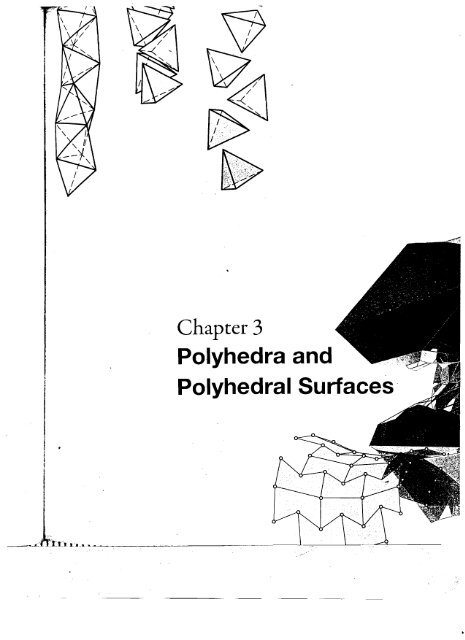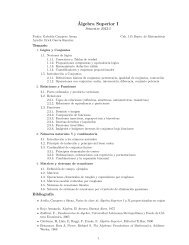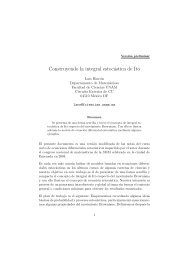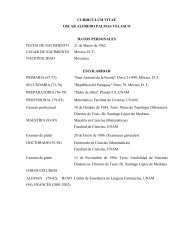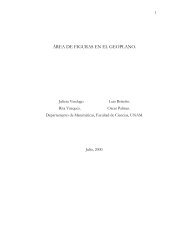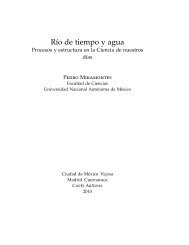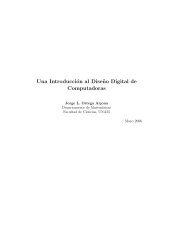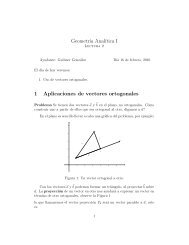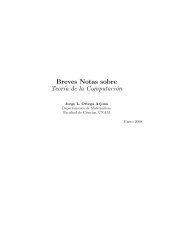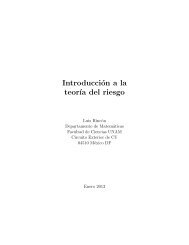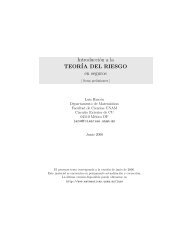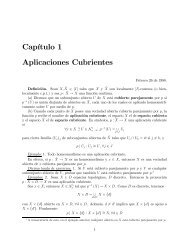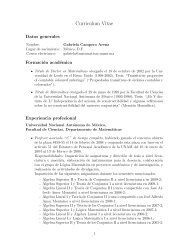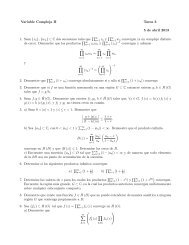Polyhedra and Polyhedral Surfaces
Polyhedra and Polyhedral Surfaces
Polyhedra and Polyhedral Surfaces
Create successful ePaper yourself
Turn your PDF publications into a flip-book with our unique Google optimized e-Paper software.
Chapter 3<br />
<strong>Polyhedra</strong><br />
<strong>Polyhedra</strong>l
Fig. 3.1<br />
polyhedra <strong>and</strong> polyhedral surfaces in<br />
architecture.<br />
(Left) The Seattle Public Library (1998-<br />
2004) by Rern Koolhaas <strong>and</strong> Joshua<br />
Rarnus.<br />
(Right) Part of the glass roof of the<br />
Dubai Festival Centre (2003-2007)<br />
by lerde <strong>and</strong> HOK (image courtesy of<br />
Waagner-Biro Stahlbau AG).<br />
<strong>Polyhedra</strong> <strong>and</strong><br />
<strong>Polyhedra</strong>l <strong>Surfaces</strong><br />
<strong>Polyhedra</strong> <strong>and</strong> polyhedral surfaces are shapes bounded by planar faces. They are<br />
fundamental to many modeling purposes <strong>and</strong> are often found in architecture (Figure<br />
3.1). Actually, most architecture features polyhedral surfaces because planar parts<br />
are easier to build than curved ones. We start our discussion with classical polyhedra<br />
such as pyramids <strong>and</strong> prisms that can be generated by extrusion of a polygon. To<br />
better underst<strong>and</strong> why only a certain limited number ofpolyhedra can be realized<br />
with congruent regular faces, we study Platonic <strong>and</strong> Archimedean solids <strong>and</strong> some of<br />
their properties. Several of the Archimedean solids can be generated by appropriately<br />
cutting off vertex pyramids of Platonic solids. One of the Platonic solids, the<br />
icosahedron, is also the polyhedron from which geodesic spheres are usually deduced.<br />
Parts ofgeodesic spheres are well known in architecture as geodesic domes. Geodesic<br />
spheres derived from an icosahedron consfst of triangular faces only. <strong>Polyhedra</strong>l<br />
surfaces are of great recent interestin architecture for the realization of freeform<br />
shapes (e.g., as steel-<strong>and</strong>-glass structures with planar glass panels.)
<strong>Polyhedra</strong> <strong>and</strong> <strong>Polyhedra</strong>l <strong>Surfaces</strong>. Apolyhedron is a 3D shape chat consists of<br />
planarfices, straight edges <strong>and</strong> vertices. Each edge is shared by exactly two faces <strong>and</strong> a[<br />
each vertew least three edges <strong>and</strong> three faces meet (Figure 3.2, left). The bounded<br />
volume enclosed by the polyhedron is sometimes considered part of the polyhedron.<br />
,4polyhedraf s;rrJI?ce is a union of finitely many planar polygons (again cal1edf;lcesj thac<br />
need not enclose a volume (Figure 3.2, right). A polyhedral surface can have boundary<br />
vertices on boundary edges. The latter only belong to one single face.<br />
Before studying polyhedra in more detail, we note that the term polyhedron is<br />
commonly used for solid <strong>and</strong> surface models of objects bounded by planar faces. A<br />
careful distinction tends to result in complicated formulations which we want to<br />
avoid. The same holds for the termpolygon which we use for polygons <strong>and</strong> polylines.<br />
Fig. 3.2<br />
The geometric entities of a<br />
(a) polyhedron <strong>and</strong> a<br />
(b) polyhedral surface are its faces,<br />
edges, <strong>and</strong> vertices.<br />
(c) The Spittelau Apartment Houses<br />
(2004-2005) in Vienna by Zaha Hadid.<br />
(d) The Booster Pump Station East<br />
(2003-2005) in Amsterdam East by<br />
Bekkering <strong>and</strong> Adams.<br />
I<br />
(a)<br />
polyhedron<br />
edges<br />
polyhedral surface
Houses<br />
]ha Hadid.<br />
n East<br />
East by<br />
Pyramids <strong>and</strong> Prisms<br />
Pyramids. One prominent type ofpolyhedron used in architecture is thepyramid.<br />
The base of an Egyptian pyramid is usually a square, <strong>and</strong> its other four faces are<br />
triangles. A general pyramid consists of a base polygon B in a plane P that is connected<br />
by triangular faces to the apex v not lying in P (Figure 3.3). Thus, the mantle M of a<br />
pyramid is a polyhedral surface with triangular faces. We obtain apyramidalfistum<br />
by cutting the pyramid with a planeEparalle1 to P. The pillar of an obelisk is one<br />
example of a pyramidal frustum (Figure 3.3).<br />
Fig. 3.3<br />
A pyramid consists of a base polygon B<br />
that is connected by triangular faces to<br />
the apex v. If we cut the pyramid with<br />
a plane E parallel to the base plane P<br />
we get a pyramidal frustum. If we<br />
put a pyramid on top of a pyramidal<br />
frustum we have an obelisk.<br />
pyramid pyramidal frustum obelisk
Prisms. Aprisnl is a polyhedron whose bottom <strong>and</strong> top face arc translated copies of<br />
each other in parallel planes (Figure 3.4). The vertices of the bottom <strong>and</strong> the top face<br />
1<br />
are connected by parallel straight line segments. Thus the side faces of a pism are<br />
parallelograms <strong>and</strong> the mantle formed by them is a polyhedral surface. If the top face is<br />
I<br />
i<br />
the special case of a rightprism (all side faces are rectangles). A special right prism is<br />
1 the cuboid previously encountered in Chapter 1.<br />
obtained by a translation orthogo~lal to the plane containing the bottom face we have<br />
Example:<br />
Modeling pyramids <strong>and</strong> prisms using<br />
extrusion. Special pyramids <strong>and</strong> prisms<br />
are often included as basic shapes in<br />
CAD systems. To model a pyramid or<br />
prism with a general basepolygon B, we<br />
use the extrusion comm<strong>and</strong> (Figure 3.4).<br />
We draw the polygon B in a plane P (eg,<br />
the xy-plane) <strong>and</strong> extrude it. A parallel<br />
extrusion takes the profile polygon B <strong>and</strong><br />
extrudes it along parallel straight lines.<br />
If the extrusion direction is orthogonal<br />
to the reference plane we generate a<br />
right prism. Otherwise (if the extrusion<br />
direction is not parallel to the reference<br />
plane) we generate a prism. A central<br />
extrusion takes the profile polygon B in<br />
P <strong>and</strong> extrudes it along the connecting<br />
lines with a chosen extrusion center v<br />
(Figure 3.4). Thus a central extrusion<br />
generates a pyramid or pyramidal<br />
frustum whose shape depends on B <strong>and</strong><br />
on the position of the apex u. Examples<br />
of pyramids <strong>and</strong> prisms in architecture<br />
are shown in Figures 3.5 <strong>and</strong> 3.6.<br />
parallel extrusion<br />
central extrusion<br />
.\<br />
Fig. 3.4<br />
Prisms <strong>and</strong> pyramids can be generated<br />
by parallel <strong>and</strong> central extrusion of a<br />
planar polygon.<br />
prism<br />
right prism<br />
pyramids
connecting<br />
In center v<br />
d extrusion<br />
pyramidal<br />
is on B <strong>and</strong><br />
t. Examples<br />
brchitecturc<br />
3.6.<br />
Fig. 3.5<br />
pyramids in architecture:<br />
(a) The ancient Egyptian pyramids of<br />
Giza (around 2500 B.C.).<br />
(b) The main pyramid in front of the<br />
Louvre (1989) in Paris by I.M. Pei: Its<br />
base square has a side length of 35<br />
meters <strong>and</strong> it reaches a height of 20.6<br />
meters.<br />
(c) The Transamerica pyramid (1969-<br />
72) in San Franciso by William Pereira<br />
is a four-sided slim pyramid with<br />
a height of 260 meters. It has two<br />
wings on opposing sides containing an<br />
elevator shaft <strong>and</strong> a staircase.<br />
(d) The Taipei 101 (1999-2004) in<br />
Taipei by C. Y. Lee. The 508 meters<br />
high building features upside down<br />
pyramidal frustums.<br />
jenerated<br />
ion of a
Fig. 3.6<br />
Prisms in architecture:<br />
(a) Castel delMonte in Bari by the Holy<br />
Roman Emperor Frederick I1 (around<br />
1240).<br />
(b) The Jewish Museum Berlin (1998-<br />
2001) by Daniel Libeskind.
Platonic Solids<br />
A cube is a special case ofa cuboid whose faces are congruent squares. Geometrically a<br />
cube is a polyhedron with 6 square faces, 12 edges <strong>and</strong> 8 vertices. In each vertex of the<br />
cube three squares meet. All dihedral angles (i.e., the angles between faces that meet in a<br />
common edge) are equal to 90 degrees. A cube has several symmetries that can be used<br />
to reflect <strong>and</strong> rotate it (see Chapter 6) so that it is always transformed onto itself. A cube<br />
also has the property to be a convex polyhedron.<br />
convex sets. A set is convex if it contains with any pair of<br />
iu points also the straight line segment connecting them<br />
(Figure 3.7). A polygon or a polyhedron is convex if it is the<br />
boundary of a convex set.<br />
A regularpolygon has its vertices equally spaced on a circle such that the nonoverlapping<br />
edges are of equal length. Examples of regular polygons are the equilateral<br />
triangle, the square, <strong>and</strong> the regular pentagon. All regular polygons are convex.<br />
Pyramids <strong>and</strong> prisms whose base is a regular polygon are convex polyhedra. If the base<br />
polygon is non-convex the pyramid or prism is a non-convex polyhedron.<br />
ly the Holy<br />
(around<br />
Convex <strong>and</strong> non-convex domains in 2D<br />
1<br />
con vex non-convex convex non-convex
Now we devote ourselves to the following question: Are there any convex polyhedra<br />
other than the cube with congruent regular polygonal faces such that the same number<br />
of faces meet at each vertex? The answer is yes <strong>and</strong> it can be shown thac there are five<br />
such polyhedral solids. They are called the Platonic solids (Figure 3.8), named afcer<br />
the ancient Greek philosopher Plato (circa 428-348 BC). The five Platonic solids are<br />
known as the tetrahedron, the hexahedron (cube), the octahedron, the dodecahedron,<br />
<strong>and</strong> the icosahedron. The prefix in the Greek name of a Platonic solid tells us the<br />
number of faces thac make up the polyhedron: cettares means four, hex six, okto eight,<br />
dodeka twelve, <strong>and</strong> eikosi twenty. Because other polyhedra with the same number of<br />
faces commonly carry the same name, the Platonic solids are ofcen distinguished by<br />
adding the word regular to the name. In this section a ,,tetrahedrona always means a<br />
regular tetrahedron <strong>and</strong> the same applies to the other Platonic solids. Let us begin with<br />
the construction of paper models of the Platonic solids.<br />
Paper models of the Platonic solids. We can construct paper models of the Platonic<br />
solids by first arranging their faces in a plane as shown in Figure 3.8. These ,,unfolded"<br />
polyhedra are cut out of paper or cardboard <strong>and</strong> then folded <strong>and</strong> glued together along<br />
the edges. For a tetrahedron, we need four equilateral triangles, for a cube, six squares,<br />
for an octahedron, eight equilateral triangles, for a dodecahedron, twelve regular<br />
pentagons, <strong>and</strong> for an icosahedron, twenty equilateral triangles. Of course, there are<br />
different possibilities in arranging the faces of each l'latonic solid on a cut-out sheet.<br />
tetrahedron<br />
.<br />
Fig. 3.8<br />
The five Platonic solids are the<br />
tetrahedron, cube, octahedron,<br />
dodecahedron, <strong>and</strong> icosahedron. We<br />
can build them out of paper using the<br />
shown cut-out sheets.<br />
cube<br />
octahedron<br />
icosahedron<br />
dodecahedron
How to find the five Platonic solids? A con-vex polyhedron is a Platonic solid if the<br />
following criteria hold.<br />
All faces are congruent regular polygons.<br />
At each vertex, the same number of faces meet.<br />
*<br />
he<br />
3n,<br />
ron. We<br />
using the<br />
Three is the minimum number of polygons (<strong>and</strong> edges) that have to meet in a vertex v<br />
of a polyhedron. All faces <strong>and</strong> edges that meet in v form the vertexpyramid. Note that<br />
by vertex pyramid we mean the mantle of a pyramid <strong>and</strong> this pyramid may have a ionplanar<br />
base polygon (Figure 3.9). A polyhedron vertex is convex if the sum of angles<br />
between consecutive edges is less than 360 degrees. This is clearly the case for the cube<br />
(Figure 3.10) because we get 3-90 = 270 degrees for the three squares joining in each<br />
vertex. Ifwe put together four squares the angle is 4.90 = 360 degrees <strong>and</strong> all four<br />
squares are contained in a plane. Therefore, we do not get a spatial polyhedron. Five or<br />
more squares will not work either. Thus, the cube is the only Platonic solid made up of<br />
squares. Let us now use equilateral triangles instead of squares.<br />
Three equilateral triangles meeting in a vertex are allowed (3.60 = 180<br />
degrees). We get the tetrahedron by adding a fourth equilateral triangle as<br />
a pyramid base (Figure 3.10). The resulting polyhedron has four faces, four<br />
vertices, <strong>and</strong> six edges. It fulfils the previously cited criteria <strong>and</strong> is thus a<br />
Platonic solid.<br />
Four equilateral triangles meeting in a corner are also allowed (4.60 = 240<br />
degrees). We obtain the octahedron simply by gluing together two such<br />
vertex pyramids along their base squares (Fig 10). Again both criteria cited<br />
previously are hlfilled <strong>and</strong> we have derived another Platonic solid. It has 8<br />
faces, 6 vertices, <strong>and</strong> 12 edges.<br />
Fig. 3.9<br />
The vertex pyramid of the polyhedron<br />
vertex v is formed by all edges <strong>and</strong><br />
faces joining in v. We also show the<br />
unfolded vertex pyramids.<br />
vertex pyramids<br />
con vex<br />
flat<br />
saddle sha~ed<br />
vertex pyramids unfolded
I<br />
I<br />
I<br />
!<br />
I<br />
;<br />
!<br />
I<br />
j<br />
I<br />
!<br />
Five equilateral triangles meeting in a corner are the most we can achieve<br />
'(5.60 = 300 degrees). But now we are not allowed to simply glue two such<br />
vertewpyramids along their pentagonal bases. The criterion would not be<br />
fulfilled for the base vertices. It turns out that we have to connect two such<br />
pyramids with a b<strong>and</strong> of 10 additional equiiateral triangles (Figure 3.10j to<br />
obtain an icosahedron. Now both criteria hold again <strong>and</strong> we have found a<br />
fourth Platonic solid. It has 20 faces, 12 vertices, <strong>and</strong> 30 edges. Note that<br />
actually all vertex pyramids of the icosahedron are formed by five equilateral<br />
triangles <strong>and</strong> are congruent.<br />
Six equilateral triangles meeting in a vertex form a planar object (6.60 = 360 degrees),<br />
<strong>and</strong> more than six cannot form a convex vertex anymore. Thus, we have derived all<br />
Platonic solids whose faces are made up of equilateral triangles or squares.<br />
Fig. 3.10<br />
How to derive the five Platonic solids<br />
using their vertex pyramids.<br />
icosahedron<br />
dodecahedron
The next regular planar polygon is the regular pentagon with five edges <strong>and</strong> an inner<br />
angle of 108 degrees. Because 3-108 = 324 < 360 degrees we can form a convcx corner<br />
out of three congruent pentagons. Then the dodecahedron is obtained by connecting<br />
four such caps consisting of th~eecon~iuenr: pentagons (Figure 3.10). Both criteria are<br />
fi~lfilled <strong>and</strong> we have derived the fifch Platonic solid. It has 12 faces, 20 vertices, <strong>and</strong> 30<br />
edges. Ifwe put four pentagons together, we have 4.108 = 432 > 360 degrees which no<br />
longer yields a convex corner.<br />
Are there Platonic solids with regular polygonal faces other than triangles, squares, or<br />
pentagons? The answer is no. The following explains why this is the case. For a regular<br />
hexagon the face angle is 120 degrees <strong>and</strong> thus three hexagons meeting in a corner are<br />
already planar (3.120 = 360). Since the face angles of the regular 7-gon, 8-gon, <strong>and</strong> so on<br />
are becoming larger <strong>and</strong> larger we can no longer form convex vertexpyramids anymore.<br />
mic Solids<br />
Platonic solids in higher dimensions. The mathematician<br />
Schlafli proved in 1852 that there are six polyhedra that<br />
fulfill the properties of the Platonic solids in 4D space. In<br />
spaces of dimension n = 5 <strong>and</strong> higher there are always only<br />
I<br />
t<br />
three such polyhedra. The three Platonic solids that exist in<br />
any dimension are the hypocube (n-dimensional cube), the<br />
simplex (n-dimensional tetrahedron), <strong>and</strong> the crosspolytope<br />
(n-dimensionaloctahedron). In dimension 3 we additionally<br />
have the dodecahedron <strong>and</strong> the icosahedron. In dimension<br />
4 there are rhe 24-cell, the 120-cell, <strong>and</strong> the 600-cell. We are<br />
*<br />
all used to seeing 2D images of 3D objects. Similarly we can<br />
create 3D images of 4D objects. Such a 3D image of a 600-<br />
cell is shown in Figure 3.1 1.<br />
Fig. 3.11<br />
Photo of a 3D image of the 600-cell at<br />
TU Vienna.
Convex polyhedra whose faces are equilateral triangles. Note that there are actually<br />
eight different convex polyhedra consisting of equilateral triangles. Three of them are<br />
the Platonic solids tetrahedron, octahedron, <strong>and</strong> icosahedron. The other $ are no<br />
longer as regular <strong>and</strong> have 6, 10, 12, 14, <strong>and</strong> 16 equilateral triangular faces (Figure<br />
3.12). They are obtained as follows. Gluing together two tetrahedra gives the first new<br />
object. Gluing together two pentagonal pyramids generates the second one.<br />
Splitting a tetrahedron into two wedges <strong>and</strong> stitching them together with a b<strong>and</strong> of<br />
eight equilateral triangles yields the third one. Attaching three square pyramids to the<br />
side faces of a triangular prism generates the fourth. Finally, by attaching two square<br />
pyramids to a b<strong>and</strong> of eight equilateral triangles we obtain the fifth one. Note that all<br />
faces that are glued together are then removed from the generated polyhedron.<br />
Fig. 3.12<br />
tetrahedron<br />
The eight different convex polyhedra<br />
that are made up of equilateral<br />
4 triangles. Only three of them are<br />
Platonic solids.<br />
--- _--- -- y-<br />
octahedron<br />
icosahedron
~olyhedra<br />
?ral<br />
n are<br />
I<br />
Properties of<br />
Platonic Solids<br />
'The faces of a Platonic solid are congruent equilateral triangles (tetrahedron,<br />
octahedron, icosahedron), or congruent squares (cube), or congruent regular<br />
pentagons (dodecahedron). Table 3.1 summarizes the number of faces (fl, the<br />
number ofvertices ( v ), <strong>and</strong> the number of edges ( e ) that form each Platonic solid.<br />
Table 3.1 Number of Faces, Vertices, <strong>and</strong> Edges Associated with Platonic Solids<br />
Platonic solid I f I v I e<br />
Tetrahedron 1 4 1 4 1 6<br />
Cube 1 6 1 8 112<br />
Octahedron<br />
8 6 12<br />
Dodecahedron 12 20 30<br />
Icosahedron<br />
20 12 30<br />
The Euler formula. It is easy to verify that for the five Platonic solids the number of<br />
vertices v minus the number of edges e plus the number of faces f is always equal to 2:<br />
.<br />
Fig. 3.13<br />
Platonic solids <strong>and</strong> their duals. The<br />
tetrahedron is self-dual. The cube <strong>and</strong><br />
the octahedron are duals of each other.<br />
The same holds for the icosahedron<br />
<strong>and</strong> the dodecahedron.<br />
This polyhedral formula, derived by the mathematician Leonhard Euler (1707-1783),<br />
actually holds for all polyhedra without holes. We verify it for the pyramid with a<br />
square base: v - e + f = 5 - 8 + 5 = 2 In Chapter 14 we will learn more about the<br />
Euler formula <strong>and</strong> other so-called topologicalproperties of geometric shapes.
Platonic solids <strong>and</strong> their duals. The face midpoints of each Platonic solid are the<br />
vertices of another Platonic solid, called the solid's dutrrzl (Figure 3.13). Let us first<br />
derive the dual ofa tetrahedron. Each of the four vertex pyramids consists of three<br />
equilateral triangles. Because ofthe symmetry of the tetrahedron the three face<br />
midpoints of each vertex pyramid form another equilateral triangle. Thus, we again<br />
obtain a convex polyhedron consisting of four equilateral triangles. Thus the dual of a<br />
tetrahedron is again a (smaller) tetrahedron contained in the original one.<br />
Let us now derive the dual of a cube. For each vertex pyramid of the cube (consisting<br />
of three congruent squares) we connect the face midpoints by an equilateral triangle.<br />
Thus each vertex of the cube gives rise to an equilateral triangle (a face of the dual<br />
polyhedron), <strong>and</strong> each face of the cube yields a vertex of the dual (which is the face<br />
midpoint of the square). Hence the dual of a cube consists of eight equilateral triangles<br />
that form an octahedron. Obviously the number ofvertices of a Platonic solid<br />
corresponds to the number of faces of the dual <strong>and</strong> vice versa. The number of edges is<br />
the same for a Platonic solid <strong>and</strong> its dual (see Table 3.1). Note that the dodecahedron<br />
<strong>and</strong> the icosahedron are duals of each other.<br />
Spheres associated with Platonic solids. There are three spheres with the same center .<br />
naturally associated with each Platonic solid (Figure 3.14). One sphere contains all<br />
vertices (the circumsphere), the second touches all faces in their face-midpoints (the<br />
insphere), <strong>and</strong> the third touches the edges at their edge-midpoints.<br />
Symmetry properties. The vertex pyramids pf a single Platonic solid are congruent<br />
with one another. By construction, all faces are congruent regular polygons <strong>and</strong> thus<br />
all edges have the same length. This means that if we want to construct a Platonic solid<br />
we have the following advantages.<br />
We only need one type of face.<br />
All edges have the same length.<br />
The dihedral angles between neighbouring faces are equal.<br />
All vertex pyramids are congruent.<br />
Fig. 3.14<br />
Each Platonic solid has three associated<br />
spheres with the same center. Here<br />
we show the circumspheres <strong>and</strong> the<br />
inspheres.
The Golden Section<br />
The golden section. Thegolden section (also known asgolden ratid or divine<br />
proportion) is the number<br />
p = (1+6)/2 - 1.618033989 ...<br />
We obtain the exact golden section if we divide a line segment into two parts (a larger<br />
one of length c, <strong>and</strong> a smaller one oflength d) so that the following holds (Figure<br />
3.15): the ratio of c <strong>and</strong> d is the same as the ratio ofc + d <strong>and</strong> c. Stated another way,<br />
"larger to smaller as total to larger." Formally, we write<br />
c:d=(c+d):c.<br />
Ewe use a new variable p := c/d we have p = 1 + 1/p which leads to the quadratic<br />
equation p2- p - 1 = 0. The positive solution (1 +6)/2 is the golden section.<br />
Interestingly, the golden section can be approximated by the ratio of two successive<br />
numbers in the so-called Fibonacciseries of numbers 1, 1,2,3, 58, 13,21,34, ... .<br />
Although 3:2 = 1.5 is a rough approximation ofp, 5 : 3 = 1.666 ... is already a little bit<br />
better. Continuing in the same fashion we obtain better approximations. For example,<br />
the value 134 = 1.625 already approximates the golden ratio within 1% accuracy.<br />
jsociated<br />
Here<br />
d the<br />
'Ihe golden rectangle. The dimensions of a golden rectangle are always in the golden<br />
ratio p : 1. To construct a golden rectangle, we start with a square of side length c. As<br />
shown in Figure 3.15 we obtain a largergolden rectangle with dimensions (c + d ): c<br />
<strong>and</strong> a smaller one with dimensions c : d.<br />
'Ihe Fibonacci spiral. Let us continue the above construction as follows. We divide<br />
the smaller rectangle into a square of side length d <strong>and</strong> another golden reccangle of<br />
dimensions d : (c - d). Ifwe continue in the same fashion the result is a whirling square<br />
diagram. By connecting opposite corners of the squares with quarter circles we obtain<br />
the Fibonacci spiral (Figure 3.15).<br />
-- -- -
History:<br />
The golden section in art <strong>and</strong> architecture. In art the<br />
golden section has been found in numerous ancient Greek<br />
sculptures-including those by Phidias (fifch century BC)<br />
whose name motivated the choice ofp as the symbol for the<br />
golden section. The golden section also appears in paintings<br />
ranging from Leonardo da Vinci's Mona Lisa (1503) to<br />
Mondrian's Composition with Red, Mow, <strong>and</strong> Blue (1921).<br />
In architecture it is argued that the golden section was<br />
used in the Cheops pyramid (around 2590-2470 B.C.), in<br />
the Parthenon temple (447-432 B.C.) in Athens, in the<br />
Pantheon (118-125) in Rome, in various triumphal arches,<br />
or in the facade of the Notre Dame cathedral (1163-1345)<br />
in Paris. In the twentieth century, Le Corbusier developed<br />
the golden-section-based modular system for architectural<br />
proportions <strong>and</strong> applied it in his famous building Unit;<br />
dJHabitation (1952) in Marseille (Figure 3.16).<br />
Fig. 3.15<br />
The golden section, the golden<br />
rectangle, <strong>and</strong> the golden spiral.<br />
golden section<br />
golden rectangle<br />
Fibonacci spiral<br />
.> , T7; : :.: ;<br />
.?'.,?< 2, .*.? $<br />
. ......;l:"<br />
.:,.; :?<br />
..*...-:;.-<br />
" :,-< -':<br />
,-*2'.>"":'"I.<br />
.<br />
1;':;:.<br />
.,. :. :-.:<br />
>.;,<br />
.>-.:. ;', .',<br />
.: ,=-<br />
. .<br />
. , ,-. .<br />
; . ^<br />
c/Z c/Z ::+:.: d. i:... .;.<br />
-.iec-<<br />
'<br />
Fig. 3.16<br />
Unite dfHabitation (1952) by<br />
Le Corbusier.
ection wa,<br />
3 B.C.), in<br />
:ns, in thC<br />
ha1 arches,<br />
163-1345)<br />
developed<br />
:hitectural<br />
ling Uniti<br />
.<br />
(a) Modeling a tetrahedron by cutting<br />
it out of a cube.<br />
(b) Modeling an octahedron by<br />
choosing its six vertices as the unit<br />
points on the axes of a Cartesian<br />
system: (1,0,0),(0,1,0),(-1,0,0),<br />
(O,-l,O),(O,O,l),(O,O,-l).<br />
Modeling the Platonic solids. CAD sohare ohen provides Platonic solids as<br />
fundamental shapes. Ifthis is not the case all five Platonic solids can also be modeled in<br />
the following way. The most difficult part here is the construct$n of an icosahedron <strong>and</strong><br />
its dual, the dodecahedron-which exhibits a beautiful relation to the golden ratio.<br />
To model a cubc, we can use parallel extrusion of a square with edge lengths<br />
in a direction orthogonal to its supporting plane to a heights.<br />
To model a tetrahedron, we cut it out of a cube as shown in Figure 3.17. Tne<br />
planar cuts generate a polyhedron whose six edges are diagonals of the cubes<br />
faces which are congruent squares. Thus, the new edges are of equal length.<br />
The four faces of the new polyhedron are congruent equilateral triangles.<br />
Hence the polyhedron is a tetrahedron.<br />
To model an octahedron (Figure 3.17), we select in six vertices as unit points<br />
on [he axes of a Cartesian system: (1,0,0), (0,1,0), (-1,0,0), (0,-1,0), (0,0,1),<br />
(0,0,-1). Alternatively we could also model it as the dual of a cube.<br />
planes -0<br />
cube<br />
tetrahedron
I<br />
TO model an icosahedron we use three congruent golden rectangles which<br />
.we position mutually orthogonal with coinciding centers in the origin as<br />
show~n Figure 3.18. The twelve vertices of the three golden recrangles have<br />
Cartesian coordinates (kp,?l,O), (0, kp,?l), (+1,0, +p) <strong>and</strong> are the vertices of<br />
an icosahedron ofedge lengths = 2.<br />
We model a dodecahedron as the dual of an icosahedron (Figure 3.18).<br />
The twenty face midpoints of the icosahedron are the vertices of the<br />
dodecahedron.<br />
The cube is the most widely used Platonic solid in architecture. One unorthodox use is<br />
illustrated in Figure 3.19a. The tetrahedron also finds its way into architec~ure (Figure<br />
3.19b). In material following we will learn how geodesic spheres can be derived from<br />
an icosahedron.<br />
. z z<br />
icosahedron dodecahedron ,j<br />
Fig. 3.18<br />
(Left) Modeling an icosahedron of edge<br />
length s = 2: The vertices of three<br />
congruent golden rectangles of width<br />
2 <strong>and</strong> length 2qdefine the twelve<br />
vertices of an icosahedron.<br />
(Right) Modeling a dodecahedron as<br />
the dual of an icosahedron.<br />
icosahedron with side length s=2<br />
Fig. 3.19<br />
(a) The Cube Houses (1984) in<br />
Rotterdam by Piet Blorn feature cubes<br />
with one vertical diagonal resting on<br />
prisms with a hexagonal base polygon.<br />
(b) The Art Tower (1990) in Mito by<br />
Arata Isozaki can be modeled as a<br />
stack of tetrahedra.
Archimedean Solids<br />
Archimedean solids are convex polyhedra that are consisting of two or more types of<br />
regular polygons so that all vertex pyramids are congruent. These special polyhedra<br />
were known to the ancient Greek genius Archimedes more than 2000 years ago. As in<br />
the case of Platonic solids, all edge lenghts are equal in an Archimedean solid. Thus,<br />
the real difference is that more than one type ofplanar face appears. Each face still has<br />
to be a regular polygon but not all of them have to be congruent.<br />
ron of edge<br />
f three<br />
; of width<br />
welve<br />
Corner cutting of Platonic solids. By cutting off the vertices of a Platonic solid we<br />
can generate some of the Archimedean solids. For a better underst<strong>and</strong>ing ofpossible<br />
cucs we first discuss corner cutting (along straight lines) for regular polygons. For each<br />
regular polygon we can perform two different corner cuts so that we again obtain a<br />
regular polygon (Figure 3.20):.<br />
Type 1: Cuts that generate a regular polygon with the same number of edges.<br />
Type 2: Cuts that generate a regular polygon with twice as many edges.<br />
) in<br />
:ure cubes<br />
!sting on<br />
;e polygon.<br />
Mito by<br />
:d as a<br />
Fig. 3.20<br />
The two types of corner cuts of regular<br />
polygons that generate another regular<br />
polygon. We illustrate the cuts for the<br />
equ~lateral tr~angle, the square, <strong>and</strong><br />
the regular pentagon.<br />
corner cuts type 1<br />
corner cuts type 2
I<br />
i<br />
The first type of cut passes through the edge midpoints, <strong>and</strong> the second type ofcut has<br />
to be ~erforrned in such a way that the generated polygon with twice as many edges is<br />
again regular. \Ve can perform these two types of corner cuts for a Platonicsolid in an<br />
analogous way <strong>and</strong> thus generate Archimedean solids. In we do so we cut off parts of<br />
the vertex pyramids.<br />
Corner cuts of type 1. Let us start with cuts through the edge midpoints (Figure 3.21).<br />
For a tetrahedron we chop o f four smaller regular tetrahedra <strong>and</strong> what<br />
remains is an octahedron, Thus, we again have a Platonic solid <strong>and</strong> not a new<br />
type of polyhedron.<br />
For a cube, we obtain the so-called cuboctahedron consisting of six congruent<br />
squares (which remain from the six faces of the cube) <strong>and</strong> eight congruent<br />
triangles (which remain from the eight corners of the cube).<br />
Ifwe cut off the corners of an octahedron, we obtain a polyhedron<br />
whose faces are eight congruent equilateral triangles (one for each of<br />
the octagon faces) <strong>and</strong> six congruent squares (one replacing each corner<br />
of the octahedron). This is again a cuboctahedron. Indeed, by corner<br />
cutting through the edge midpoints dual Platonic solids generate the<br />
same polyhedron. This also holds for the dodecahedron <strong>and</strong> its dual, the<br />
icosahedron.<br />
With planar cuts through the edge midpoints of a dodecahedron we obtain<br />
a polyhedron whose faces are 12 congruent regular pentagons (one for<br />
each of the twelve faces of the dodecahedron) <strong>and</strong> 20 congruent equilateral<br />
triangles (one for each of the 20 vertices of the dodecahedron). The derived<br />
~ol~hedron is known as the icosidodecahedron. Its name reveals the fact that<br />
it can also be generated from an icosahedron via corner cutting through the<br />
edge midpoints (Figure 3,21).<br />
Fig. 3.21<br />
New polyhedra generated by corner<br />
cutting of Platonic solids with cuts<br />
through the edge midpoints.<br />
tetrahedron<br />
cube octahedron dodecahedron icosahedron<br />
corner<br />
cutting<br />
i<br />
octahedron<br />
J<br />
corner corner ,<br />
cutting<br />
cutting<br />
cuboctahedron<br />
icosidodecahedron
Corner cuts of type 2. With corner cuts of the second type we can generate one<br />
further Archimedean solid for each of the five Placonic solids (Figurr 3.22). Figure<br />
3.20 indicates by means of a single face how we have to perform the necessary cllcs<br />
that chop off parts of the vertex pyramids of each Platonic solid. Archimedean solids<br />
generated by rruncacion are called truncated tetrai~edron, truncated cube, truncated<br />
octahedron, truncated dodecuhedron, <strong>and</strong> truncated icosahedron.<br />
The truncated icosahedron is very likely the most recognized Archimedean solid<br />
because ic is represented in the classic shape of a soccer ball (Figure 3.22). The same<br />
polyhedron was also named a buckyballby chemists, because it resembles the shape of<br />
the geodesic spheres ofBuckminister Fuller which we study in the next section. It can<br />
be generated from the icosahedron by corner cutting so that we chop off 1/3 of each<br />
edge on both edge ends. We generate for each of the 12 vertices a regular pentagon,<br />
<strong>and</strong> for each of the 20 triangles of the icosahedron a regular hexagon. Corner cutting<br />
is a fundamental idea in generating new shapes from existing ones. We encounter this<br />
idea again in future chapters including Chapter 8 (on freeform curves) <strong>and</strong> Chapter<br />
1 1 (on freeform surfaces).<br />
Fig. 3.22<br />
From the 13 Archimedean solids the<br />
seven named in this figure can be<br />
generated from Platonic solids via<br />
corner cutting. The classic soccer ball<br />
is one of them.<br />
In total, there are 13 different Archimedean solids (Figure 3.22) other than certain<br />
prisms <strong>and</strong> anti-prisms (discussed in material following). 'Ihree of the Archimedean<br />
solids even consist of three different types of regular polygonal faces.<br />
:orner<br />
cuts<br />
truncated<br />
octahedron<br />
I<br />
truncated<br />
dodecahedron
Remark. Note-that the classical definiton of an Archimedean solid is also fulfilled by<br />
a 14th polyhedron. It was found 2000 years afier Archimedes by J. C. P. iMiller <strong>and</strong> V.<br />
G. Ashkinuze. This polyhedron is obtained by cutting a rhombicuboctahedron (the<br />
polyhedron marked by an ' in Figure 3.22) in ha[( rotating one part by 45 degrees, <strong>and</strong><br />
then gluing the two parts together.<br />
Some Archimedean solids inherently closely resemble the shape of a sphere, with the<br />
further advantage that they can be made of struts of equal length. From Platonic solids<br />
we derive polyhedra that resemble the shape ofa sphere even better. These are the<br />
geodesic spheres <strong>and</strong> spherical caps of them are called geodesic domes.<br />
I<br />
Example:<br />
I Prisms <strong>and</strong> anti-prisms that are congruent regular polygons as bottom<br />
Archimedean solids. A prism whose <strong>and</strong> top faces. The top face is a rotated<br />
top <strong>and</strong> bottom faces are congruent<br />
regular polygons <strong>and</strong> whose side faces<br />
are squares is an Archimedean solid<br />
(Figure 3.23, top). Recall that for an<br />
Archimedean solid all edge lengths<br />
have to be equal. An anti-prism has<br />
<strong>and</strong> translated copy of the bottom face<br />
<strong>and</strong> both are connected by a strip of<br />
triangles. If we use equilateral triangles<br />
we obtain polyhedra that fulfill the<br />
properties of an Archimedean solid<br />
(Figure 3.23, bottom).<br />
cube<br />
prisms<br />
Fig. 3.23<br />
Examples of prisms <strong>and</strong> anti-prisms<br />
that are Archimedean solids.<br />
octahedron<br />
anti-prisms
Geodesic Spheres<br />
Ageodesicsphere is a polyhedron with an almost spherical structure. The name is<br />
derived from the fact that<br />
all vertices lie on a common sphere S<strong>and</strong><br />
certain sequences ofvertices are arranged on great circles ofS.<br />
The great circles of a sphere are the shortest paths that connect two distinct points on<br />
a sphere. These shortest paths on a surface are calledgeodesics, <strong>and</strong> thus the polyhedra<br />
we study in chis section are called geodesic spheres. All faces of a geodesic sphere are<br />
triangles. However, not all of them are congruent. Geodesic domes are those parts<br />
of geodesic spheres (Figure 3.24) that are actually used in architecture (Figure 3.25).<br />
Built domes range from sizes covering almost a full geodesic sphere to only half a<br />
geodesic sphere. The latter are called hemispherical domes.<br />
I<br />
dome at the Milan Triennale-an international exhibition<br />
I<br />
dedicated to present innovative developments in<br />
architecture, design, crafts, <strong>and</strong> city planning. The 42-foot<br />
paperboard geodesic dome of Fuller gained worldwide<br />
attention <strong>and</strong> Fuller won che Gran Premio. Buckminster<br />
Fuller built several domes including a large one in Montreal<br />
(Figure 3.25) to house the U.S. Pavilion at Expo 1967. Fuller<br />
also proposed enclosing midtown Manhattan with a 2-milewide<br />
dome.<br />
geodesic sphere<br />
hemispherical geodesic dome
Fig. 3.25<br />
(a) The Geodesic Dome (1967) in<br />
Montreal by Buckminster Fuller<br />
comprises three-quarters of a geodesic<br />
sphere. The outer-hull is made out of<br />
triangles <strong>and</strong> is Jinked to the inner hull<br />
consisting of hexagons.<br />
(b) The Spaceship Earth geodesic<br />
dome (1982) in Orl<strong>and</strong>o is almost a full<br />
geodesic sphere.<br />
(c) The Desert Dome (1999-2002) in<br />
Omaha is hemispherical.
Starting with Platonic solids we derive different forms of geodesic spheres by applying<br />
the following iterative process: we subdivide each face into .I iegular pattern of<br />
triangles <strong>and</strong> project t!e 13r..v vertices onto the circumsphere a&the P lnic solid.<br />
From our considerations<br />
'latonic solids it is evident that geodesic ~lomes cannot be<br />
built with all triangular f~ccs being congruent. Zowever, we try to obtain only a small<br />
number of different faces.<br />
) in<br />
r<br />
geodesic<br />
! out of<br />
lner hull<br />
sic<br />
ost a full<br />
Fig. 3.26<br />
Subdividing a triangle into smaller<br />
triangles: By splitting each edge into<br />
2, 3, 4 equal segments we get 4, 9, 16<br />
smaller triangles. In general, splitting<br />
each edge into n qqual segments yields<br />
n2 smaller triangles.<br />
Geodesic domes derived from an icosahedron: Alternative 1. Because the<br />
icosahedron closely approximates its circumsphere it is often used as a starting point<br />
for deriving geodesic spheres. We start by subdividing the triangular faces into<br />
smaller triangles (Figure 3.26b). An equilateral triangle can be split into four smaller<br />
equilateral triangles by adding the edge midpoints as new vertices. ?hen three new<br />
edges parallel to the original edges are inserted.<br />
We do this subdivision for each of the 20 congruent faces of the icosahedron to<br />
obtain a total of 80 = 20.4 triangles. Now we project the newly inserted 30 vertices<br />
(the midpoints of the 30 edges of the icosahedron) radially from the center of the<br />
icosahedron onto its circumsphere (Figure 3.27). From the 80 triangles of this<br />
geodesic sphere, 20 are still equilateral. The remaining 60 are only isosceles. Thus this<br />
geodesic sphere can be made up of two types of triangles (colored differently in Figure<br />
3.28, level 1).<br />
Fig. 3.27<br />
Projecting the edge midpoints of an<br />
icosahedron onto its circumsphere<br />
results in a geodesic sphere.<br />
icosahedron<br />
geodesic sphere<br />
+:<br />
'vide each<br />
/<br />
project new vert<br />
onto circumsphere
I<br />
Ifwe want to construct a larger geodesic sphere, it is advantageous to have more triangles.<br />
Let us again derive such a geodesic sphere from an icosahedron. We subdivide each<br />
edge of the icosahedraa into three equal parts <strong>and</strong> obtain for each triangle nine smaller<br />
triangles (instead offour, as previously; Figure 3.26~). Then we project the 80 new<br />
vertices (2 on each of the 30 edges ofthe icosahedron, <strong>and</strong> one for the midpoint ~feach<br />
of the 20 faces) again radially onto the circumsphere of the icosahedron.<br />
This geodesic sphere has a total of 92 vertices, 20.9 = 180 triangles, <strong>and</strong> 270 edges<br />
(Figure 3.28, level 2). It follows from the construction that all triangles are isosceles.<br />
However, there are two different types of triangles: 60 congruent ones that form the<br />
vertex pyramids around the 12 original vertices of the icosahedron <strong>and</strong> 120 congruent<br />
ones that form the 20 vertex pyramids around the displaced midpoints of the<br />
icosahedroni triangles.<br />
Note that there are only three different edge lengths involved. If we subdivide each<br />
triangle of the icosahedron into 16 triangles (Figure 3.26d), <strong>and</strong> then project all new<br />
vertices onto the circumsphere, we obtain a geodesic sphere at level 3 with 20.16 = 320<br />
triangles (Figure 3.28, level 3). Ifwe keep subdividing the triangles of the icosahedron in<br />
this fashion, we generate a geodesic sphere at level k with 2O.(k+l)' triangles.<br />
Geodesic domes derived from an icosahedron: Alternative 2. An alternative<br />
approach in generating geodesic spheres also starts with an icosahedron. However, it<br />
recursively splits each triangle of the geodesic sphere at the previous level into four<br />
smaller triangles <strong>and</strong> then projects the new vertices onto the circumsphere (Figure<br />
3.29). The first subdivision level gives exactly the same geodesic sphere with 20.4 =<br />
80 triangles as before. But the second <strong>and</strong> third level already produce geodesic spheres<br />
with 20.16 = 320, <strong>and</strong> 20.64 = 1280 triangles respectively. Thus, by the second<br />
subdivision approach a geodesic sphere of level k has 20.8 criangles. At level 1, both<br />
alternative constructions return the same geodesic sphere. However, at higher levels<br />
we obtain geometrically different results because the order in which we perform the<br />
: ~ i subdivision <strong>and</strong> projection steps is different.<br />
. .<br />
1<br />
Fig. 3.28<br />
Geodesic spheres generated by<br />
subdividing the triangles of an<br />
icosahedron <strong>and</strong> projecting the new<br />
vertices:<br />
(a) At level 1 we have 80 triangles of<br />
two types (20 equilateral, 60 isosceles<br />
in different colors).<br />
(b) At level 2 we have 180 isosceles<br />
triangles of two types marked with<br />
different colors.<br />
(c) At level 3 we have 320 triangles of<br />
five different types. Only 20 of them<br />
are equilateral, all others are isosceles.<br />
icosahedron geodesic sphere level 1 geodesic sphere level 2 geodesic sphere level 3<br />
@, .-;..<br />
, . ' ,.: ., ,. ', .,' .<br />
";<br />
j:; i<br />
--<br />
&;I<br />
q<br />
* --. - .<br />
.<br />
-. .<br />
.<br />
9 8<br />
, '..::<br />
, ,?<br />
:. .<br />
i ',.'.<br />
. -.<br />
,>,<br />
.. ,- ..<br />
,- "<br />
~
Figure 3.30 shows a circular section <strong>and</strong> the different resulrs obtained by changing the<br />
order in which subdivision <strong>and</strong> projecrion are starting with a single edge.<br />
Thus, although the number of triangles ofa geodesic sphere at level 2,3,4, ... with the<br />
second approach is the same as the number of triangles ofa geodesic sphere at level<br />
3,7, 15, ... generated with the first approach, the geometiy of the resulting objec:s is<br />
slightly different. By varying the generation process (subdivision <strong>and</strong> projection) we<br />
can obtain even other variants of geodesic spheres.<br />
Remark. Note that a geodesic sphere still contains the 12 vertices of rhe icosahedron<br />
from which it is constructed. These 12 vertex pyramids consist ofonly 5 triangles.<br />
All other vertex pyramids of a geodesic sphere consist of 6 triangles which yields a<br />
natural relation to hexagons that can be formed around those vertices. Recent projects<br />
(such as "Eden" by Grimshaw <strong>and</strong> partners) are revisiting large spherical roofs using a<br />
hexagonal pattern (see Chapter 11 for details).<br />
Fig. 3.29<br />
Geodesic spheres generated with the<br />
second subdivision alternative, In each<br />
step the triangles of the previous step<br />
are split into four smaller triangles <strong>and</strong><br />
the new vertices are projected again<br />
radially onto the circumsphere of the<br />
icosahedron.<br />
icosahedron geodesic sphere level 1 geodesic sphere level 2 geodesic sphere level 3<br />
~sceles<br />
with<br />
jngles of<br />
f them<br />
isosceles.<br />
Fig. 3.30<br />
The order c?f subdivision <strong>and</strong> projection<br />
steps matters. This is illustrated at<br />
h<strong>and</strong> of a circular section. alternative 1<br />
0<br />
alternative 2<br />
0
hombic dodecahedra honeycombs Fig. 3.31<br />
Examples of space filling polyhedra:<br />
rhombic dodecahedra <strong>and</strong><br />
A honeycombs.
Space Filling <strong>Polyhedra</strong><br />
Obviously the cube is a space-filling polyhedron. This means that we can stack<br />
congruent cubes <strong>and</strong> completely fill 3D space with them. Actually, the cube is the only<br />
Platonic solid that has this property. Nevertheless, there are other polyhedra that have<br />
the space-filling property. One example is the following: Ifwe add square pyramids<br />
of height s/2 to each face of a cube with edge lengths, we obtain a so-called rhombic<br />
dodecahedron (Figure 3.31a). All faces of a rhombic dodecahedron are congruent<br />
rhombi which are non-regular polygons of equal edge length in the form of a sheared<br />
square.<br />
Let's examine why the rhombic dodecahedron is also a space-filling polyhedron. We<br />
take a cube <strong>and</strong> attach six congruent cubes to its faces. Replacing these six cubes by<br />
rhombic dodecahedrae, the initial cube is completely filled by six congruent pyramidal<br />
parts of the adjacent rhombic dodecahedrae. Thus, ifwe replace in a space-filling<br />
%<br />
assembly of cubes every second cube (in a 3D checkerboard manner) with a rhombic<br />
dodecahedron, we find a space-filling by dodecahedra. Space-filling polyhedra appear<br />
in nature (e.g. as regular six-sided prisms that form the building blocks of honeycombs,<br />
Figure 3.3 lb).<br />
It is of course possible to fill space with non-congruent polyhedra, although it becomes<br />
much more complicated to do this in a meaningful way. For practical applications we<br />
sometimes want to fill a certain volume with polyhedra. For simulation purposes one<br />
Fig. 3.32<br />
Volume filling tetrahedra (image
ohen uses tetrahedra (Figure 3.32). One recent example in architecture that employs<br />
space-filling polyhedra of varying shape is the National Swimming Center in Beijing<br />
(Figure 3.33). An architectural design that employs polyhedra derived from so-called<br />
. .<br />
Voronoi cells (see Chapter 17) ir shown in Figure 5.34.<br />
Fig. 3.33<br />
Volume filling polyhedra in<br />
architecture: National Swimming<br />
Center in Beijing.<br />
Fig. 3.34<br />
An architectural design based on<br />
irregular space filling polyhedra (image<br />
courtesy of 6. Schneider).<br />
I
yhedra <strong>Surfaces</strong><br />
Ifa smooth surface is approximated by a polyhedral surface we also speak of a discrete<br />
su+ce. In architecture discrete surfaces are ofspecial interest in the realization of a design.<br />
Approximation of cylinders <strong>and</strong> cones by polyhedral surfaces. The first idea is to<br />
take a smooth cylinder surface <strong>and</strong> replace ir with a strip model (Figure 3.35a). We<br />
can also divide each strip intoplanar quadrilaterals. The same holds for a cone surface.<br />
Figure 3.35b shows a strip model <strong>and</strong> a model with planar quadrilaterals. Note that<br />
the quadrilaterals are planar because two opposing edges are lying in the same plane by<br />
construction.<br />
a (image<br />
Fig. 3.35<br />
Approximation of cylinders <strong>and</strong> cones<br />
by polyhedral surfaces.<br />
(a) Simple strip models.<br />
(b) The strips are further subdivided<br />
into planar quadrilaterals.<br />
(c) Since 1991 the Melbourne Shot<br />
Tower is covered by a 84m high conical<br />
glass roof designed by Kisho Kurokawa.<br />
m<br />
non-congruent quadrangles
Example:<br />
A model of the courtyard roof of the in the middle <strong>and</strong> two congruent<br />
Abbey in Neumunster. The previous conical sections at either side. The<br />
idea was used to cover a rectangular circular arc c is the base curve of two<br />
area by a curved roof with planar glass adjacent surfaces. Then, a parallel<br />
panels in an interesting way (Figure extrusion generates the cylindrical<br />
3.36a). The shape of the roof consists part-<strong>and</strong> a central extrusion with<br />
of three parts: a cylindrical section vertex v generates the conical one. The
cylinder surface is approximated by if we use a different decomposition<br />
congruent planar quadrilaterals using into quadrilaterals, they are no longer<br />
the generators of the cylinder.<br />
planar. Thus, to realize chis design with<br />
If we approximate the conical parts by planar glass panels one has to subdivide<br />
planar quadrilaterals using the cone each nonplanar quadrilateral into two<br />
generators, the outcome might be triangles (Figure 3.36~).<br />
undesirable (Figure 3.36b). However,<br />
Fig. 3.36<br />
(a) The courtyard roof of the Abbey in<br />
Neumunster (2003) by Ewart-Haagen<br />
& Lorang Architects,built by RFR.<br />
(b) A design only using the generators<br />
of the cylinder <strong>and</strong> the cones.<br />
(c) An alternative design that<br />
discretizes the conical parts into<br />
triangles.
In general, the approximation of a freeform shape by triangles is much simpler than by<br />
planar polygons. This fact is intensively used in computer graphics, in which objects<br />
are decomposed into triangles (e.g. for rendering purposes, recall Chapter 2). In<br />
architecture, freeform-shapes are enjoying increased popularity. For the design of roofs<br />
constructed as steel-<strong>and</strong>-glass structures with planar panels, the simplest polygons are<br />
triangles (Figure 3.37).<br />
Fig. 3.37<br />
The Zlote Tarasy (polish for "Golden<br />
Terraces") in Warsaw by Jerde<br />
Partnership International opened in<br />
2007. The freeform shape roof is<br />
geometrically a polyhedral surface with<br />
triangular faces (images courtesy of<br />
Waagner-Biro Stahlbau AG).
Whereas three vertices of a triangle in space are always contained in a single plane,<br />
chis need not be the case for four or more points. The design of polyhedral freeform<br />
surfaces with planar faces other than triangles is a difficult task that is a topic ofcurrent<br />
research. As illustrated in Figure 3.38, computer graphics has already developed<br />
algorithms for the approximation of arbitrary shapes by polyhedral surfaces. However,<br />
these methods generate a variety of differently shaped planar polygons <strong>and</strong> thus may<br />
not be the best solution for architectural design. Therefore, in Chapter 19 we study a<br />
different approach that becter meets the needs ofarchitecture.<br />
Fiq. 3.38<br />
Shape approximation by polyhedral<br />
surfaces applied to Michelangelo's<br />
David (image courtesy of Pierre Alliez).<br />
I<br />
B<br />
i


